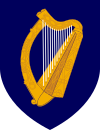| Constitution of Ireland | |
|---|---|
 | |
| Overview | |
| Original title | Bunreacht na hÉireann |
| Jurisdiction | Republic of Ireland |
| Ratified | 1 July 1937 |
| Date effective | 29 December 1937 |
| System | Unitary parliamentary republic |
| Government structure | |
| Branches | |
| Head of state | President of Ireland |
| Chambers | Bicameral (Dáil Éireann and Seanad Éireann) |
| Executive | Government of Ireland |
| Judiciary | |
| History | |
| Amendments | 32 |
| Last amended | 11 June 2019 |
| Citation | Constitution of Ireland |
| Supersedes | Constitution of the Irish Free State |
| Full text | |
 |
|---|
The Constitution of Ireland (Irish: Bunreacht na hÉireann, pronounced [ˈbˠʊnˠɾˠəxt̪ˠ n̪ˠə ˈheːɾʲən̪ˠ]) is the fundamental law of Ireland. It asserts the national sovereignty of the Irish people. It guarantees certain fundamental rights, along with a popularly elected non-executive president, a bicameral parliament, a separation of powers and judicial review.
It is the second constitution of the Irish state since independence, replacing the 1922 Constitution of the Irish Free State.[1] It came into force on 29 December 1937 following a statewide plebiscite held on 1 July 1937. The Constitution may be amended solely by a national referendum.[2] It is the longest continually operating republican constitution within the European Union.[3]
- ^ "Constitution of Ireland Bunreacht Na hÉireann". The All-Party Oireachtas Committee on the Constitution. Archived from the original on 21 July 2011. Retrieved 24 August 2008.
- ^ Article 46(2)
- ^ Marie-Luce Paris 'Popular Sovereignty and the Use of the Referendum – Comparative Perspectives with Reference to France', University College Dublin, 2012